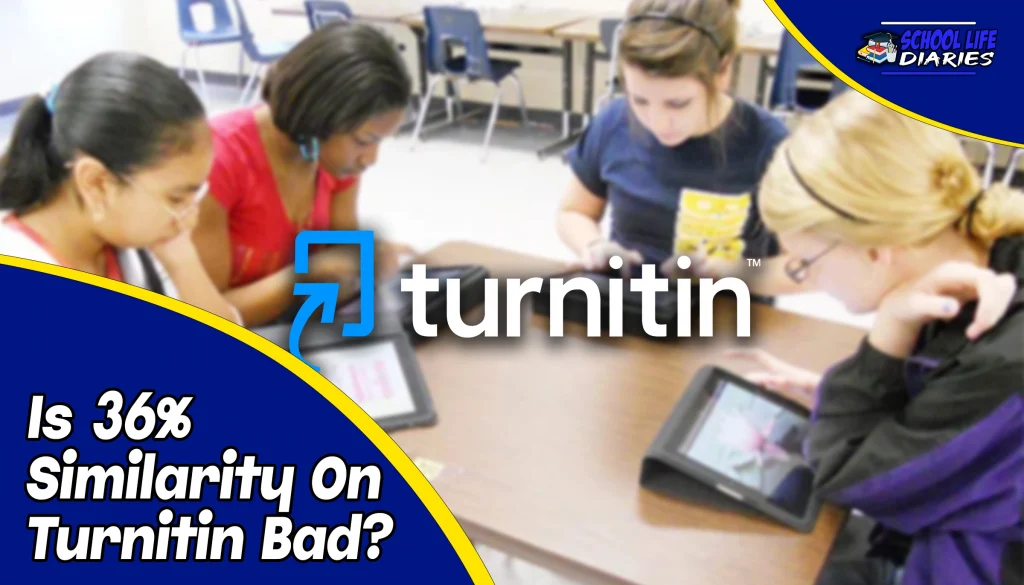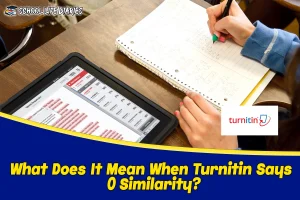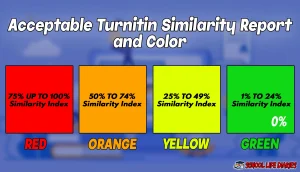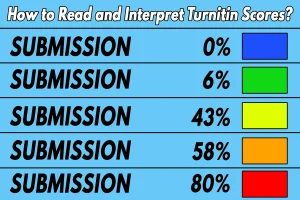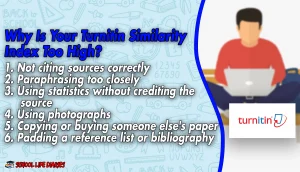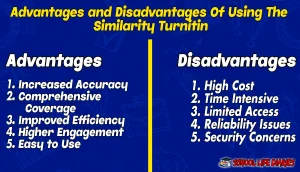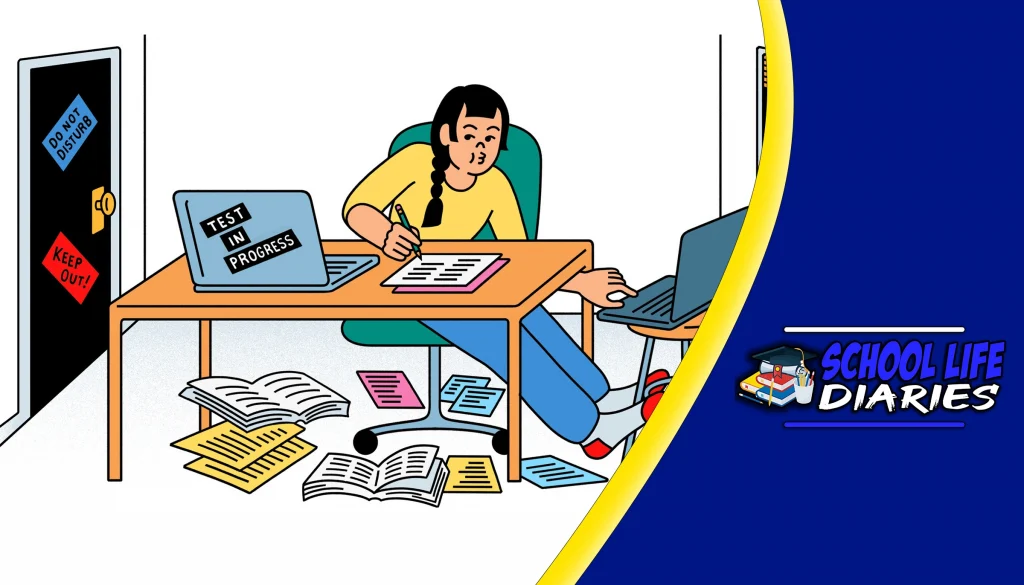Turnitin is here to help. This powerful program offers users a sophisticated suite of academic integrity tools, allowing them to conveniently and quickly detect potential problems that could lead to violations of copyright law. Not only can it detect plagiarism, but it provides feedback with originality reports of Similarity Turnitin Bad so users can track down the source of any improper citation or misuse of information.
Yes. Although there is no set standard for what constitutes an acceptable percentage of similarity, any score above 20 or 25 percent is considered too high and may indicate plagiarism or improper citation. It can be said that the lower the percentage of similarity, the better. In order to ensure that your work is original and properly cited, you should always strive for a similarity score of 5% or lower.
Make sure to include all sources in your references list and double check that you have not accidentally plagiarized any text or ideas without giving credit where it is due. If you are having difficulty reducing the similarity score on your paper, you may want to consider using a professional editing service to help.
Acceptable Turnitin Percentage: How Much Is Too Much Percentage
The acceptable Turnitin percentage is anything below 25% in the similarity report. A Turnitin plagiarism score of 25% and below demonstrates that the paper is original and adequately supported through sources from credible sources. Any plagiarism score beyond 25%, however, could be an indication of excessive use of other people’s ideas or words without due credit.
It is important to make sure that any ideas or literature referenced in the paper are adequately cited and referenced. Doing so will help ensure that the Turnitin score remains below 25%, and show that your work is both honest and original. The goal should always be to have a plagiarism score of 25% or less in the similarity report. This will help demonstrate the authenticity and originality of your work, and show that it is supported by sufficient sources.
How Does Turnitin Work?
Turnitin is an automated online plagiarism detection system that helps educational institutions and instructors detect and prevent plagiarism in written assignments. It works by comparing documents submitted by students to a vast archive of web pages, books, journals, and other sources.
When a student submits their assignment, Turnitin creates a digital “fingerprint” of their paper. This fingerprint is compared to millions of other documents in its database, including those submitted by other students. If there are any similarities between the student’s paper and another document, Turnitin will alert the instructor or institution.
Turnitin Similarity How Much Is Too Much
When considering the issues of plagiarism in academic submissions, it is important to note that there is a fine line between appropriate citation and accidental plagiarism. While citations are necessary to properly credit original sources and acknowledge research, paraphrasing cited material can often be mistaken for plagiarism by Turnitin or other automated services.
To ensure that your paper is free of any plagiarism, it is recommended to keep the plagiarism index below 10%. This number may vary depending on the institution and some institutions accept a higher index of 20-30%, including citations. To practice good academic integrity, it is best to err on the side of caution and strive for a plagiarism index that falls below 10%.
It is recommended to consult your professor or the institution’s guidelines on plagiarism. This way you can be sure that your paper meets all of the requirements and standards set by the institution. If needed, there are many online resources available that can help you identify and avoid any plagiarism issues in your paper.
What Does It Mean When Turnitin Says 0 Similarity?
When Turnitin says “0 Similarity,” it means that your paper has no matches to any other sources in their database and is likely 100% unique. It is a sign that the paper did not come from a source outside of the student, such as an internet source or another student’s work. This result indicates that the content was written by the student submitting it and was not plagiarized.
For students submitting work, a 0 Similarity score provides assurance that their paper is original and not plagiarized. It’s also important to note that this result only applies to the sources in Turnitin’s database; a 0 Similarity score does not guarantee that a student has not used information from an outside source without citation.
When Is A Turnitin Percentage Of 40 Good Or Bad?
Turnitin’s score of 40 can be seen as an indicator that a student has done a good job of writing an original paper. The student should ensure that the content is cited correctly and that any outside sources are properly credited. If the Turnitin report shows some overlap with existing material, this could mean that citations have been missed or incorrectly placed – something that must be rectified before submitting their work.
It is important to note that a Turnitin score of 40 does not necessarily mean that no plagiarism has occurred, but rather that the paper likely has some original content and citations. To ensure a high level of accuracy, students should take the time to review their own work and make sure it meets academic standards.
Turnitin Similarity Varies From One University To Another
Turnitin’s similarity score varies from one university to the next and can be highly influential in determining the success or failure of a student’s academic performance. The score evaluates a submitted paper for originality, looking for areas of content that have been copied or paraphrased from other sources.
A paper’s similarity score is based not only on how much content has been plagiarized but also on the type and quality of sources used. It is important for students to understand what their similarity score means and how it can affect their academic success.
Why A Little Plagiarism Is Good?
Plagiarism is an issue that has long been a concern among academics and educators. While plagiarism is generally considered to be an immoral act, there can also be positive aspects to it. A little plagiarism, in certain cases, can be beneficial because it shows that the author made an effort to conduct research while writing the paper.
When using external sources to back up arguments, it is almost impossible to avoid having some matching tests that will give low scores on a plagiarism scanner. A score of 1-10% can be considered good and should not be seen as an issue. This is encouraged in order for the paper to have more depth and accuracy.
What Percentage Of Turnitin Is Bad?
Turnitin similarity score is considered bad when it rises above 30%. Anything beyond 49% is unacceptable as it shows a substantial amount of copied content from other sources. The exact percentage where plagiarism can be identified varies depending on the university or institution and can even differ between departments within the same institution.
It is important to remember that even if the Turnitin similarity score is below 30%, plagiarism can still be identified if matching content is not properly cited and referenced. This means that it is always important to paraphrase and cite any content taken from another source, regardless of the similarity score. Students should also look out for overlapping words or phrases in their reports. These words may highlight content that needs to be properly cited and referenced.
What Contributes To The Acceptable Percentage of Plagiarism?
The acceptable percentage of plagiarism is largely determined by the purpose and context of a given piece of work. Plagiarism is considered to be any use of another individual’s words, ideas, or work without proper acknowledgment or citation. When considering the acceptability of plagiarism, it is important to note that some forms can be more damaging than others.
For example, deliberately plagiarizing a work without providing credit to the original author would be considered highly unacceptable, while accidentally including a few lines of unacknowledged material in an otherwise original piece of work may be more acceptable.
Acceptable Turnitin Similarity Report and Color
The Turnitin similarity report is an effective tool used to detect any potential plagiarism in submitted works. It compares the content of a paper with texts found both online and in its own database, then assigns a score based on how much matching text it finds. The scores are reported in percentages, ranging from 0% up to 100%. The higher the percentage, the more similarity is detected.
The similarity report icons come in different colors to indicate the score of each document. Blue indicates no matching texts were found, green indicates 1% to 24%, yellow represents 25% to 49%, orange stands for 50% to 74%, and red signifies 75% up to 100%. The scores are conveniently located in the top right corner of each report, making it easy to see how close each submission is to potential plagiarism.
It is important to note that Turnitin does not have a strict set of rules or guidelines dictating whether a submission fails or passes its similarity checks. While a score of 0% is generally considered satisfactory, many institutions have different guidelines on acceptable scores. It is always best to check with your institution for their specific policies before submitting any work.
How To Read and Interpret Turnitin Scores?
Turnitin’s originality score is a measure of how much the text in your paper matches content from Turnitin’s database. This percentage can range from 0% to 100%, with the higher percentages indicating a greater number of matches. The way you interpret the results will vary based on your purpose and context.
A score of 0-5% is very good and indicates that your paper has few matches to content in the database. A score between 6-24% is still acceptable, but a score between 25-49% requires revision before submission. Anything above 50% should be further investigated for plagiarism. A score of more than 75% indicates that your paper is unacceptable and it should be rewritten (not revised) in its entirety. This is because it shows that you have plagiarized your paper.
How To Check Similarity On Turnitin Before Submitting?
Checking the similarity of a paper before submitting it to Turnitin is an important part of ensuring your paper meets the standards set forth by your institution. To check the similarity of your paper, you’ll need to follow a few simple steps.
Create an account with Turnitin and upload your completed paper in Microsoft Word or PDF format. Once your paper has been uploaded, you’ll be able to run a similarity check to determine if there is any content that could be considered plagiarized.
The results of the scan will be displayed on your screen in the form of an “originality report” outlining any similarities that were found. Depending on the settings of your institution’s Turnitin account. You may be given the option to review any passages found before submitting your paper.
It’s important to take this step seriously as even very small portions of plagiarized content can lead to a failing grade or other disciplinary action from your institution. If there are passages that appear to be plagiarized, it’s best to delete or rephrase them before submitting your paper.
Once you’re satisfied that all content is original, you can submit your paper for review. The Turnitin score provided by the report will indicate how much of the paper is considered “unoriginal” and can be used to help you identify any areas of your paper that need further revision.
Is There A Free Version Of Turnitin?
No, there is no free version of Turnitin available. Turnitin is a paid plagiarism detection service that can be used to assess the originality of student work and detect potential acts of academic dishonesty. It works by scanning submitted documents or websites and comparing them against an extensive database of sources.
To access the full range of features Turnitin offers, you will need to purchase a subscription. Once subscribed, users can upload assignments and receive comprehensive reports on the originality of their work. Turnitin also provides teachers with powerful tools for monitoring and managing student submissions.
Does Turnitin Check Previously Submitted Work?
Yes, Turnitin does check for previously submitted work. Turnitin utilizes an extensive database of works that have been submitted to its platform over the years to detect any similarities between your work and previously submitted work. This helps detect potential instances of plagiarism in the text you submit.
Turnitin’s algorithm assesses the text of your work and compares it to billions of sources from around the world. It also checks for potential matches between similar words, phrases, and even sentence structures that can indicate plagiarism.
Can You Submit A Paper To Turnitin Twice?
No, submitting a paper to Turnitin twice is not allowed as the platform will recognize the same paper and flag it as plagiarism. The purpose of Turnitin is to check for potential originality and prevent students from plagiarizing content. Submitting a paper multiple times would completely defeat this purpose. Turnitin has algorithms and filters implemented to detect duplicate content.
Can a high Turnitin similarity score lead to plagiarism allegations?
Yes, a high Turnitin similarity score can potentially lead to plagiarism allegations or at least trigger a review of the submitted work for possible plagiarism. However, it’s important to understand that a high similarity score does not automatically confirm plagiarism. Turnitin does not make determinations of plagiarism; it simply flags areas of similarity with existing sources.
When a high similarity score is generated, it indicates that a significant portion of the submitted work matches content from other sources.
Why Is Your Turnitin Similarity Index Too High?
The Turnitin similarity index can be high for a variety of reasons. It’s important to understand why your index is too high and what steps you can take to lower it. Here are six common reasons why a Turnitin similarity index might be too high:
1. Not citing sources correctly:
Not providing proper citations or providing incorrect citations can dramatically increase your similarity index. Make sure that all sources are properly cited for each assignment to help reduce the amount of flagged content.
2. Paraphrasing too closely:
Using excessive quotes, or paraphrasing material without changing the words sufficiently, can lead to a high Turnitin similarity index. Be sure to read through any paraphrased material and adjust it to ensure that the words are sufficiently changed so as not to trigger a flag.
3. Using statistics without crediting the source:
When incorporating research or statistics in an assignment, be sure to credit the original source. If you fail to do so, your Turnitin similarity index may be too high.
4. Using photographs:
Photos from online sources often contain embedded text that can be detected by Turnitin and cause the similarity index to rise. If you intend to use images or photos, try to find ones without any text, or cite the source of the image properly.
5. Copying or buying someone else’s paper:
Plagiarism is one of the quickest ways to get a high Turnitin similarity index. Never copy or buy someone else’s work and submit it as your own as this may result in severe disciplinary action.
6. Padding a reference list or bibliography:
Padding your reference list with unrelated sources that have not been used in your paper can trigger Turnitin’s algorithms, resulting in a high similarity index. Be sure to only include sources that you actually cite or use in the text of your assignment.
How To Reduce Similarity On Turnitin For Your Essay?
1. Use quotation marks where necessary when using words, ideas or theories from sources to ensure proper citation.
2. Paraphrase as much of your text as possible and make sure not to copy long passages verbatim.
3. Cite all sources accurately in-text and on your reference page according to the required formatting guidelines (APA, MLA, etc.).
4. Check for accidental plagiarism by submitting the essay through a plagiarism detection tool prior to submission.
5. If possible, submit a paper that you haven’t submitted previously elsewhere or even on Turnitin – reusing/recreating an old paper will result in higher similarity scores due to saved records on their database already.
Difference Between Similarity and Plagiarism
1. Similarity is the use of someone else’s work but with proper credit given to them. Plagiarism is the act of taking someone else’s work and not giving credit or citing the original source.
2. Similarity emphasizes finding patterns in different sources. While plagiarism focuses more on copying without giving credit.
3. Similarity is a process of being able to determine the original source while plagiarism involves misrepresenting someone else’s work as one’s own.
4. Similarity encourages learning and borrowing insights from others. While plagiarism diverts attention away from the original source and its creator.
5. Similarity allows a person to build on the work of others. While plagiarism is seen as an unethical and dishonest act.
How Can Students Reduce Similarity Percentages On Turnitin?
Turnitin is a plagiarism detection tool commonly used by educational institutions to check for originality and similarity in students’ work. If you’re looking to reduce similarity percentages on Turnitin, it’s important to understand that the goal should always be producing original and properly cited work. Here are some strategies to help reduce similarity percentages on Turnitin:
1. Understand the Assignment and Guidelines:
Ensure you thoroughly understand the assignment, guidelines, and expectations provided by your instructor. Misinterpretation or misunderstanding of requirements can lead to unintentional plagiarism.
2. Properly Cite Sources:
Always cite your sources correctly using the appropriate citation style (e.g., APA, MLA, Chicago). Any direct quotes, paraphrased information, or ideas borrowed from others must be properly attributed.
3. Paraphrase Effectively:
When using information from sources, paraphrase the content in your own words while maintaining the original meaning. Avoid merely rearranging words or sentence structures.
4. Add Original Insights:
Incorporate your own thoughts, analysis, and commentary into your writing. Provide unique perspectives and interpretations of the topic to demonstrate originality.
5. Use Multiple Sources:
Utilize a variety of reputable sources to gather information and present a well-rounded view of the topic. This can help in producing diverse and original content.
6. Plan and Organize Your Work:
Develop a clear outline and plan for your assignment. Organize your ideas logically and ensure that your paper flows coherently. A well-structured paper is less likely to contain unintentional similarities.
Advantages and Disadvantages Of Using The Similarity Turnitin
Advantages Of Using The Similarity Turnitin
1. Increased Accuracy:
The similarity checker of Turnitin helps identify potential plagiarism by comparing submitted student papers. This ensures that any copied, reused or paraphrased material is identified quickly and reliably.
2. Comprehensive Coverage:
Turnitin’s similarity checker is constantly updated with new content, ensuring comprehensive coverage of digital sources and enabling educators to detect potential plagiarism quickly and accurately.
3. Improved Efficiency:
The automated process of the similarity checker eliminates the need for manual assessment, helping educators save time and energy when verifying the authenticity of submitted student papers.
4. Higher Engagement:
By using Turnitin’s similarity checker students are encouraged to develop better research and writing skills, as they are aware that their work will be compared against a large database of existing content. This allows educators to create an engaging learning environment where students strive for academic excellence.
5. Easy to Use:
Turnitin’s similarity checker is easy to use and integrates with popular learning management systems. Making it simple for educators to assign, review, and grade submissions quickly and accurately.
Disadvantages Of Using The Similarity Turnitin
1. High Cost:
Using the similarity turnitin can come with a high price tag, depending on the type of subscription chosen. It can become quite expensive, especially if multiple users or large amounts of content need to be checked.
2. Time Intensive:
Checking for similarities in documents with the turnitin tool can be a time-intensive task. It first requires manually entering each document into the system, and then waiting for Turnitin to complete its comparison process. Finally, it must be reviewed by a human to assess any potential issues found.
3. Limited Access:
For those who may not have access to the internet or Turnitin, they are unable to use the tool. This can be an issue for those in rural or remote areas with limited access to such services.
4. Reliability Issues:
There have been reports of inaccurate results from Turnitin due to its reliance on algorithms and lack of human oversight during the comparison process. This means that users may miss instances of plagiarism or incorrectly flag innocent content as similar.
5. Security Concerns:
As turnitin stores all uploaded documents and their results in its system. There are potential privacy and security risks to consider when using the service. These must be taken into account before entrusting it with sensitive data or materials.
Conclusion:
If you’re a student and have received a 36% similarity score on Turnitin, there’s no need to panic. A low similarity score simply means that your paper needs to be more original. You can fix this by ensuring that you paraphrase and quote sources correctly, and by citing your sources properly.
For more tips on how to improve your similarity score, check out our blog post on the topic. If you’re a teacher who uses Turnitin, make sure you understand how the tool works so that you can accurately interpret your students’ results.

